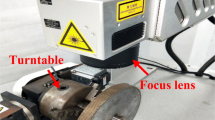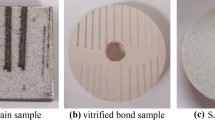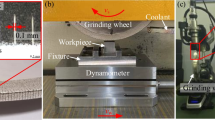Abstract
Grooved grinding wheels play an important role in reducing grinding thermal damage. Aluminum oxide grinding wheels of approximately 1 mm slot width and 35% groove ratio were successfully fabricated using a novel reciprocating ultrafast laser scanning mode to improve the grinding stability. Grinding experiments with grooved and non-grooved wheels were conducted on 42CrMo. The cutting mechanisms of grooved structures were analyzed with the established cutting kinematics of the abrasives in the groove edges and the grinding force components model. The decreased grinding forces were observed and analyzed with abrasive cutting mechanisms, indicating that grooved structures can increase the undeformed chip thickness of grains at the slot edges and decrease the specific grinding energy by reducing the specific plowing and sliding energy. The grooved grinding wheels exhibited high performance in inhibiting grinding heat and workpiece burns. The burned workpiece ground with non-grooved wheels experienced a phase transformation and had a high tensile residual stress state on the ground surface and subsurface, while compressive residual stresses were detected on the unburned workpiece surface ground with grooved wheels. Grooved grinding wheels can improve the grinding quality of workpieces due to the lower grinding temperature and residual stress.



















Similar content being viewed by others
References
Malkin S, Guo C (2007) Thermal analysis of grinding. CIRP Ann - Manuf Technol 56:760–782. https://doi.org/10.1016/j.cirp.2007.10.005
Zhao Z, Qian N, Ding W, Wang Y, Fu Y (2020) Profile grinding of DZ125 nickel-based superalloy: grinding heat, temperature field, and surface quality. J Manuf Process 57:10–22. https://doi.org/10.1016/j.jmapro.2020.06.022
Wang J, Xu J, Wang X, Zhang X, Song X, Chen X (2019) A comprehensive study on surface integrity of nickel-based superalloy Inconel 718 under robotic belt grinding. Mater Manuf Process 34:61–69. https://doi.org/10.1080/10426914.2018.1512137
Sieniawski J, Nadolny K (2018) Experimental study into the grinding force in surface grinding of steel CrV12 utilizing a zonal centrifugal coolant provision system. Proc Inst Mech Eng Part B J Eng Manuf 232:394–403. https://doi.org/10.1177/0954405416645256
Heinzel C, Rickens K (2009) Engineered wheels for grinding of optical glass. CIRP Ann - Manuf Technol 58:315–318. https://doi.org/10.1016/j.cirp.2009.03.096
Nguyen T, Zhang LC (2009) Performance of a new segmented grinding wheel system. Int J Mach Tool Manuf 49:291–296. https://doi.org/10.1016/j.ijmachtools.2008.10.015
Aurich JC, Kirsch B (2013) Improved coolant supply through slotted grinding wheel. CIRP Ann - Manuf Technol 62:363–366. https://doi.org/10.1016/j.cirp.2013.03.071
Li HN, Axinte D (2016) Textured grinding wheels: a review. Int J Mach Tool Manuf 109:8–35. https://doi.org/10.1016/j.ijmachtools.2016.07.001
Mao C, Long P, Tang W, Xiao L, Luo Y, Shu Z, Hu Y, Bi ZM, Lin Z, Guan F (2022) Simulation and experiment of electroplated grinding wheel with orderly-micro-grooves. J Manuf Process 79:284–295. https://doi.org/10.1016/j.jmapro.2022.04.063
Costa S, Pereira M, Ribeiro J, Soares D (2022) Texturing methods of abrasive grinding wheels: a systematic review. Materials 15:8044. https://doi.org/10.3390/ma15228044
Mohamed A-MO, Bauer R, Warkentin A (2013) Application of shallow circumferential grooved wheels to creep-feed grinding. J Mater Process Technol 213:700–706. https://doi.org/10.1016/j.jmatprotec.2012.11.029
Denkena B, Grove T, Göttsching T (2015) Grinding with patterned grinding wheels. CIRP J Manuf Sci Technol 8:12–21. https://doi.org/10.1016/j.cirpj.2014.10.005
Guo B, Zhang J, Wu M, Zhao Q, Liu H, Monier A, Wang J (2020) Water assisted pulsed laser machining of micro-structured surface on CVD diamond coating tools. J Manuf Process 56:591–601. https://doi.org/10.1016/j.jmapro.2020.04.066
Walter C, Komischke T, Kuster F, Wegener K (2014) Laser-structured grinding tools – generation of prototype patterns and performance evaluation. J Mater Process Technol 214:951–961. https://doi.org/10.1016/j.jmatprotec.2013.11.015
Pratap A, Patra K (2020) Combined effects of tool surface texturing, cutting parameters and minimum quantity lubrication (MQL) pressure on micro-grinding of BK7 glass. J Manuf Process 54:374–392. https://doi.org/10.1016/j.jmapro.2020.03.024
Malkin S, Guo C (2008) Grinding technology: theory and applications of machining with abrasives, 2nd ed. Industrial Press, New York, pp 43–127
Yu H, Lyu Y, Wang J (2019) Green manufacturing with a bionic surface structured grinding wheel-specific energy analysis. Int J Adv Manuf Technol 104:2999–3005. https://doi.org/10.1007/s00170-019-04159-2
Guo Z, Guo B, Wu G, Xiang Y, Meng Q, Jia J, Zhao Q, Li K, Zeng Z (2023) Three-dimensional topography modelling and grinding performance evaluating of micro-structured CVD diamond grinding wheel. Int J Mech Sci 244:108079. https://doi.org/10.1016/j.ijmecsci.2022.108079
Setti D, Arrabiyeh PA, Kirsch B, Heintz M, Aurich JC (2020) Analytical and experimental investigations on the mechanisms of surface generation in micro grinding. Int J Mach Tool Manuf 149:103489. https://doi.org/10.1016/j.ijmachtools.2019.103489
Aslan D, Budak E (2015) Surface roughness and thermo-mechanical force modeling for grinding operations with regular and circumferentially grooved wheels. J Mater Process Technol 223:75–90. https://doi.org/10.1016/j.jmatprotec.2015.03.023
Wang H, Zhao K, Shen H, Yao Z (2020) Experimental study on direct fabrication of micro channel on fused silica by picosecond laser. J Manuf Process 55:87–95. https://doi.org/10.1016/j.jmapro.2020.03.057
Hou Z, Yao Z, Sun Y, Shen H (2022) Grooving profile control for structured grinding wheels with picosecond pulsed laser. Int J Adv Manuf Technol 119:5851–5862. https://doi.org/10.1007/s00170-022-08655-w
Wang L, Tian X, Lu Q, Li Y (2017) Material removal characteristics of 20CrMnTi steel in single grit cutting. Mater Manuf Process 32:1528–1536. https://doi.org/10.1080/10426914.2017.1279298
Qu S, Yao P, Gong Y, Yang Y, Chu D, Zhu Q (2022) Modelling and grinding characteristics of unidirectional C–SiCs. Ceram Int 48:8314–8324. https://doi.org/10.1016/j.ceramint.2021.12.036
Kannappan S, Malkin S (1972) Effects of grain size and operating parameters on the mechanics of grinding. J Eng Ind 94:833–842. https://doi.org/10.1115/1.3428258
Ding W, Zhang L, Li Z, Zhu Y, Su H, Xu J (2017) Review on grinding-induced residual stresses in metallic materials. Int J Adv Manuf Technol 88:2939–2968. https://doi.org/10.1007/s00170-016-8998-1
Wang L, Tang X, Wang L, Yang N, Chen X, Li P, Liu G, Liu G (2019) Mechanism of grinding-induced burns and cracks in 20CrMnTi steel gear. Mater Manuf Process 34:1143–1150. https://doi.org/10.1080/10426914.2019.1605173
Ben Fredj N, Sidhom H, Braham C (2006) Ground surface improvement of the austenitic stainless steel AISI 304 using cryogenic cooling. Surf Coat Technol 200:4846–4860. https://doi.org/10.1016/j.surfcoat.2005.04.050
Balart MJ, Bouzina A, Edwards L, Fitzpatrick ME (2004) The onset of tensile residual stresses in grinding of hardened steels. Mater Sci Eng A 367:132–142. https://doi.org/10.1016/j.msea.2003.10.239
Funding
This work was supported by the National Natural Science Foundation of China under Grant Nos. U20A20284 and 52075323.
Author information
Authors and Affiliations
Contributions
Zhibao Hou was involved in conceptualization, methodology, investigation, experimental measurement, data curation, and writing—original draft. Xifang Zhang was involved in investigation, experimental measurement, and data curation. Zhenqiang Yao was involved in conceptualization, methodology writing—review and editing, project administration, and funding acquisition.
Corresponding author
Ethics declarations
Competing interests
The authors declare no competing interests.
Additional information
Publisher’s note
Springer Nature remains neutral with regard to jurisdictional claims in published maps and institutional affiliations.
Rights and permissions
Springer Nature or its licensor (e.g. a society or other partner) holds exclusive rights to this article under a publishing agreement with the author(s) or other rightsholder(s); author self-archiving of the accepted manuscript version of this article is solely governed by the terms of such publishing agreement and applicable law.
About this article
Cite this article
Hou, Z., Zhang, X. & Yao, Z. Investigation of cutting mechanism and residual stress state with grooved grinding wheels. Int J Adv Manuf Technol 128, 1455–1471 (2023). https://doi.org/10.1007/s00170-023-11933-w
Received:
Accepted:
Published:
Issue Date:
DOI: https://doi.org/10.1007/s00170-023-11933-w




